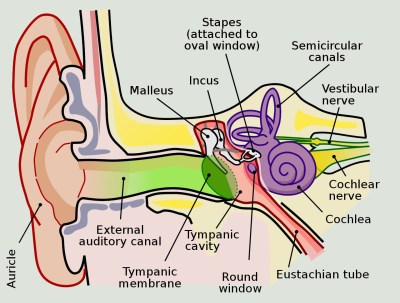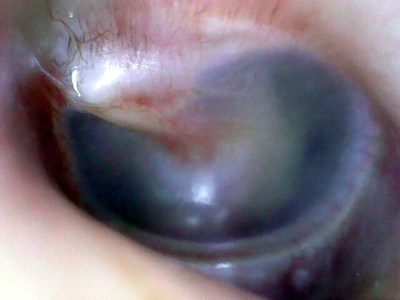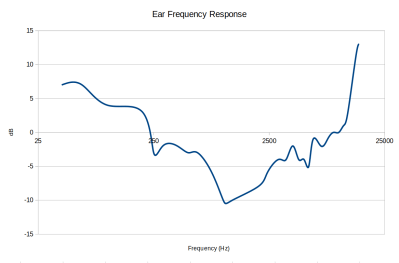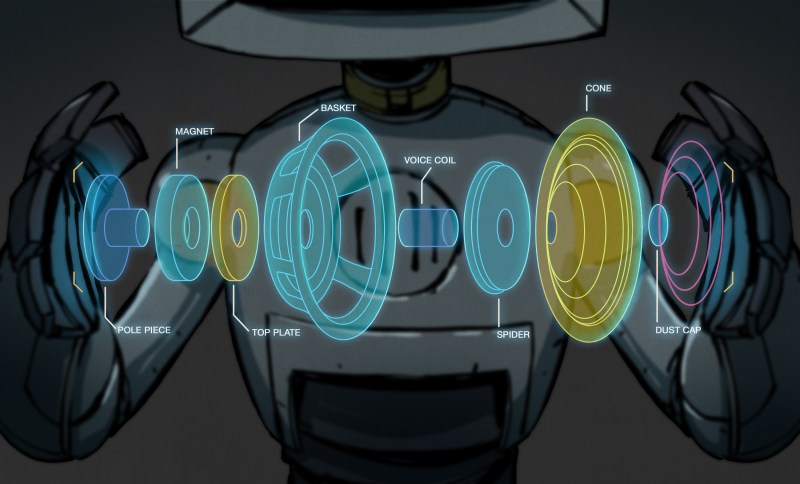A lot of our projects make noise. It can be something as simple as a microcontroller driving a small speaker or a truly ambitious Hi-Fi project, but common to all of them is the desire to get that sound out in as audible and high-quality a manner as possible. We’ve been known to make fun of the more preposterous side of the Hi-Fi world at times, but behind it all there’s a basis of solid and provable audio engineering that can be brought to bear on almost any project involving sound and electronics. Perhaps it’s time to devote some time to a series exploring the topic, and what better place to start than the ultimate destination for all that sound. Any Hi-Fi is only as good as the ears of the person listening to it, so in out journey through the world of audio that’s where we’ll start.
The Most Beautiful Piece Of Audio Equipment You Own

A diagram of the three main zones containing the inner workings of the human ear will no doubt be familiar to any Hackaday reader who has sat through a high school biology class. There’s the outer ear which we’re all used to seeing in the mirror, behind that is the middle ear, and further inside the inner ear.
The outer ear and canal are more than just an odd-shaped bodily accoutrement, instead they’re a sound reflector designed to catch sounds and channel them to the ear canal which channels sound to the middle ear. They have a frequency response all of their own, resulting in a peak for most people somewhere around 3.5 kHz. At the end of the ear canal is the tympanic membrane, a diaphragm that vibrates with the sound and transmits it to the structures in the middle ear. Behind the tympanic membrane are a set of three small bones that form a lever system which transfers the vibrations through another membrane to the liquid-filled inner ear. Their function is described as impedance matching, ensuring that the vibrations are transmitted to the liquid at the correct amplitude. A system of muscles in the inner ear act as a gain control, allowing the ear to desensitise itself and protect the inner ear from very loud noises. Finally in the liquid-filled inner ear are a set of spiral tubes with nerve endings that sense the pressure changes of the sound, and transmit the information to the brain.

This beautiful and intricate mechanism has to last a lifetime, and over that time it suffers from both ageing, and whatever wear and tear life throws at it. When I was a youngster I could hear the 15.625 kHz whine of a 625-line CRT TV set in operation or the squeak of bats catching insects on a summer’s evening, but now I can’t. As I’ve aged, my tympanic membrane and other ear parts have become stiffer, meaning that like almost everyone over the age of about 20, I can’t hear those high frequencies any more.
Similarly, any ear damage from loud noises or disease affects hearing performance, so if you had a fondness for live heavy metal, then your hearing has probably suffered. I’m fortunate as someone who was in the right place at the right time do sound and light engineering at more than a few raves back in the day, that I had the sense to wear those little foam ear plugs. My generation’s version of the old 1960s joke is that if you can remember 1990 you weren’t really there man, but at least my ears can’t remember it and I don’t have to live with tinnitus.
How Much Listening Pleasure Has Father Time Taken Away?

The point of all this is that while a five-year-old with no hearing problems has near-perfect hearing, those of us who are old enough to pursue Hi-Fi are not so lucky. Age has degraded our hearing, but the question is, by how much? It was time to characterise my ears, and for that after fooling around with a signal generator for a while I found a much better way to do that using recordings of sound at gradated amplitude intervals. It allows a graph to be generated showing the minimum audible sound level at a given frequency, and while the results should perhaps be taken with a pinch of salt because they rely on uncalibrated equipment they do at least give a useful picture of hearing bandwidth.
The lowest frequency I could hear at all with the signal generator was around 30 Hz, while I had difficulty in hearing much above 16 kHz. This is pretty normal for someone of my age, and it seems those foam ear plugs saved me from too much damage at the hands of The Shamen, KLF, or Human Resource. It shows how those bats around 20 kHz and above that I could hear as a youngster are now an impossibility to hear. The curve backs this up, with a few lumps and bumps in the middle that may reflect my headphones as much as me.
The Point Of All This Aural Musing
Talking about ears is very interesting stuff and I’d like to invite you all to plot your own response curves in the same way, but the real reason for going through all this is to remind readers that the best audio equipment in the world is not going to improve the listening ability of their ears. Unless you are a five-year-old child, the weakest point in any listening chain is located on the side of your head, and once that has been understood then the process of audio design becomes one of presenting your ears with the best quality audio within their parameters rather than trying to give them something they simply aren’t capable of resolving. Something to bear in mind, should you fall too far down the Hi-Fi rabbit hole.
All that sound has to reach those ears somehow, so to continue this series we’ll be looking at the next link in the chain. Loudspeakers are the single component that can bring out the best in an inexpensive audio set-up or ruin the sound of a good one, and we’ll be examining their design and construction from a tech perspective to help you you discern the good from the bad, and to make your own creations as good as they can be.
















Question is that graph for both ears? Have you thought about doing the ears separate?
I had a ear infection in one ear, and my I can’t hear high freq in that ear well. The difference
is quite stark.
Same here. I sleep with my head on one side because it’s quieter that way.
Novel selfie, but forgive me if I hope it doesn’t start a trend!
For people interested in a scientific approach to HiFi: https://www.audiosciencereview.com/forum/index.php?reviews/
Im pushing 40 and can still clearly hear the bats.. also been to alot of freeparty raves and dub soundsystems. I have a theory the bass actually keeps my ears flexible.
… although might add that traumatic experiences seem to attenuate your hearing as well
Same as myself. 40 and I can still hear bats, CRTs, the odd USB charger and those teenager keep away things. I was a drummer for a large portion of my teens-mid 30s, and had a reputation of being loud (without earplugs might I add) but that may just have increased the regularity of my tinnitus (been there as long as I can remember). I think hearing well at this range is more of an exception than the norm, but it’s still common enough.
Those 3 bones and that muscle can calcify with age and muscles if not used loose strength. My mom grew up in quiet times and couldn’t stand the pedal organ bass at church. My trauma was a 1F cap popping it’s top a foot from my head. I have a notch at that 3.5kHz peak and 4 semitones there are mixed into a polytone. Robins don’t sound the same even though I can still lip-teeth whistle their song.
The “Hearing Test” android app is good for creating a personal audiogram.
https://play.google.com/store/apps/details?id=mobile.eaudiologia&hl=en
Great app at least I know I am not deaf now 😃
Every single concert and rave I’ve ever been to has be with “musicians earplugs” and boy am I glad I did. They attenuate the sound flatly across the frequencies so it is just quieter, not muffled like the little yellow ones do. Great investment of about $13
I use little bits of scrunched up bog roll. It’s always available, so I can’t forget to bring it and it glows under UV! Subjectively it seemed to attenuate higher frequencies more.
Same, I love music earplugs. They take away the headache inducing percussion of over-driven megawatt sound systems at concerts & music festivals, and make everything sound so clear without muting any frequencies. Plus I can have conversations with people next to me at normal volume levels rather than yelling because I can’t even hear my own voice. Truly a great <$20 investment.
I’m over 50 and can still hear a mouse fart in the next room. I’ve been very very careful all my life to always wear ear protection. Rock concerts had full tissue in ears. No noises like saws or nail guns without putting tissue in my ears. Reason I was careful is my father an avid hunter shot guns his whole life, and at 40 lost most of his hearing. My grandmother worked in a loud factory and same thing, deaf. I was careful and it’s paid off so far. Take care and NEVER let loud noises in. And while I’m at it brush your teeth.
Environment, age, and genetics all play a role. I suffered numerous ear infections and surgeries in my childhood, I worked in an iron foundry during my 20’s, and both of my grandfathers had to wear hearing aids later in life.
I have no illusions on where things are going, I try to preserve what little I have for as long as I can. But eventually I’m going to need some hearing aids and eventually Cochlear implants. And maybe by then there will be treatments that reverse some hearing loss.
” It was time to characterise my ears, and for that after fooling around with a signal generator for a while I found a much better way to do that using recordings of sound at gradated amplitude intervals”
How did you make sure that your audio path generates proper pressure? Each headphones have their own “contour” so have audio interfaces and amplifiers. Not to mention general loudness control when you pair them. Other than that wouldn’t it be better to have your hearing tested by a professional with calibrated equipment? People tend to fool themselves while self testing – even honest one.
I think I mentioned that the curve might be influenced by my headphones and it’s not a perfect measurement.
Some of us in 40 years:
“Grandpa, why do you listen to that old music?”
“Well child, none of today’s music sounds as good as a Roland 303 and 808 thumping away at 180 bpm.”
word.
Hey @Jenny great writing!
If you’re making this a series may I suggest that after the next one on speakers, possibly some good topics would be on FET vs. MOSFET vs. Transistor vs. Opamp vs. Triode amplifiers and Room Acoustics (reverberation time and such)!
An interesting characteristic of the human ear is that its tonal response is not linear until an SPL of 100 db is attained.